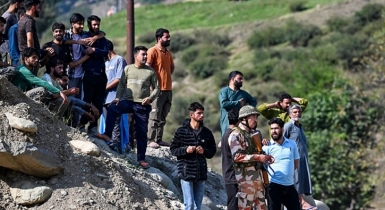
Dhaka, the bustling capital of Bangladesh, teeming with life with over 20 million inhabitants crammed within 1,500 square kilometers.
And one of the major issues here is the housing crisis. The city's infrastructure crumbles under the weight of its population. Traffic noise become a daily frustration, pollution reaches alarming levels, and essential services like water and electricity are stretched beyond capacity. The pressure on resources also fuels social issues like poverty, crime, and public health concerns.
A government plan from 2019 estimated that about 60% of the city is used for homes. However, this doesn't count all the homes that have been illegally turned into shops or other businesses. The same plan also estimated that 15% of the city is used for businesses, which might not include all the small, informal businesses that operate on the streets.
The city has experienced massive migration from rural areas, leading to a rise in poverty. The population of Dhaka is estimated to be 89,06,039, with an average annual growth rate of over seven percent over the last three decades. The city is projected to become the fourth largest city with 22 million populations by 2015. The city's central part is already built up, but its expansion is restricted by rivers, canals, and low-lying flood-prone areas. Over 49% of wetland areas decreased between 1960 and 2008, and many of these areas are already encroached. The Dhaka Metropolitan Development Plan 1995-2015 indicates eight flood-flow zones, but many of these are already encroached, hampering natural water flow and causing severe waterlogging and flooding.
The extensive use of groundwater but minimal recharge leads to high risks of drinking water scarcity. Underdeveloped sewerage and waste disposal pose a question of sustainability for dense communities. Fire safety issues are not highly emphasized from a city planning perspective in Bangladesh, with organically developed areas having risk of unimaginable loss due to fire, earthquake, and earthquake-induced fires.
Recently, an intimidating trend has emerged where residential buildings are turned into hotels and lounges, becoming the breed for unethical activities. This alarming situation has given rise to a host of concerns, including drug abuse, security threats, and many more. These buildings, which used to be peaceful homes for families, have now become locations for illegal and immoral activities. Drug abuse, in particular, has become a significant problem in these converted spaces. The appeal of privacy and anonymity has attracted people involved in illegal drug trading, making the existing drug issue in the city even worse.
It is concerning to see residential buildings being turned into places that were never meant to be used for business. This sudden growth of these establishments is happening very quickly, making it hard for the authorities to keep track of everything.
The environmental consequences are equally disconcerting. The influx of businesses operating within residential buildings has led to an increase in criminal activities, clashes between groups, noise pollution, and inadequate waste management practices. The lack of proper infrastructure to handle commercial activities within residential areas has also resulted in the haphazard disposal of waste, contributing to the degradation of the environment.
To address the issue, several steps can be taken to mitigate the problem and restore the integrity of these neighborhoods. Here are some simple yet effective ways to tackle this issue:
Strengthen regulations: Implement stricter regulations and zoning laws that clearly define the purpose of residential buildings. Enforce these regulations to prevent their unauthorized conversion into commercial establishments. This will discourage individuals from engaging in unethical activities within these spaces.
Strengthening Enforcement: Authorities need to strengthen enforcement through regular inspections and stricter penalties for illegal conversions. This could involve collaborating with residents to identify and report such activities.
Empowering Communities: Engaging residents through awareness campaigns and participatory planning fosters a sense of ownership and encourages them to report suspicious activities. Supporting resident-led initiatives like neighborhood watch programs and beautification projects can strengthen social bonds and deter illegal activities.
Fostering Sustainable Development: Strategically planned mixed-use development projects can provide designated commercial spaces within the city, reducing pressure on residential areas. Upgrading infrastructure in underserved areas can incentivize residents to stay and invest in their communities, reducing the incentive to convert their homes for commercial purposes.
Addressing Underlying Issues: Addressing the shortage of affordable housing by exploring public-private partnerships and promoting vertical housing solutions can ease the pressure on existing residential areas. Providing residents, particularly those operating informal businesses, with access to microfinance and skills training programs can create alternative, legal income sources, reducing their reliance on unethical activities.
Promoting Transparency and Accountability: Transparent communication between authorities and residents regarding enforcement efforts and development plans can foster trust and collaboration. Ensuring accountability from all stakeholders, including developers, businesses, and individuals involved in unethical practices, is crucial for long-term success.
Authorities should conduct regular inspections and take swift action against violators to discourage this unethical practice.
The widespread use of microphones by hawkers and beggars as they roam from street to street has led to another problem—causing sound pollution and disturbance. The loud noise can have detrimental effects on patients and disrupt the concentration of students.
This was never intended to be part of their trade, yet it has become a common practice over the years. The cacophony can be heard throughout the neighborhood, creating a constant stream of noise that lasts for the whole day.
The consequences of this sound pollution are particularly severe for patients, especially cardiovascular patients. The loud and continuous noise disturbs and affects their well-being, making it difficult for them to rest. Hospitals and healthcare facilities, which should be places of recovery, are now subject to intrusive noises that hamper the whole process. The constant barrage of amplified voices makes it challenging for students to concentrate on their studies, both at home and in educational institutions, leading to a negative impact on their education.
This issue requires a comprehensive approach. Local authorities should implement regulations that restrict the use of microphones by hawkers and beggars, particularly in hospitals, residential and educational areas. Enforcement of these regulations, along with regular monitoring, can help control sound pollution. Additionally, public awareness campaigns can educate street vendors about the negative effects of excessive noise on the community. By encouraging, quieter methods of communication and trade.
Despite the problem, by working collaboratively and implementing these strategies, Dhaka can transform itself into a thriving, responsible communities for all.
This writer is a student. She can be reached at introscience4@gmail.com





































